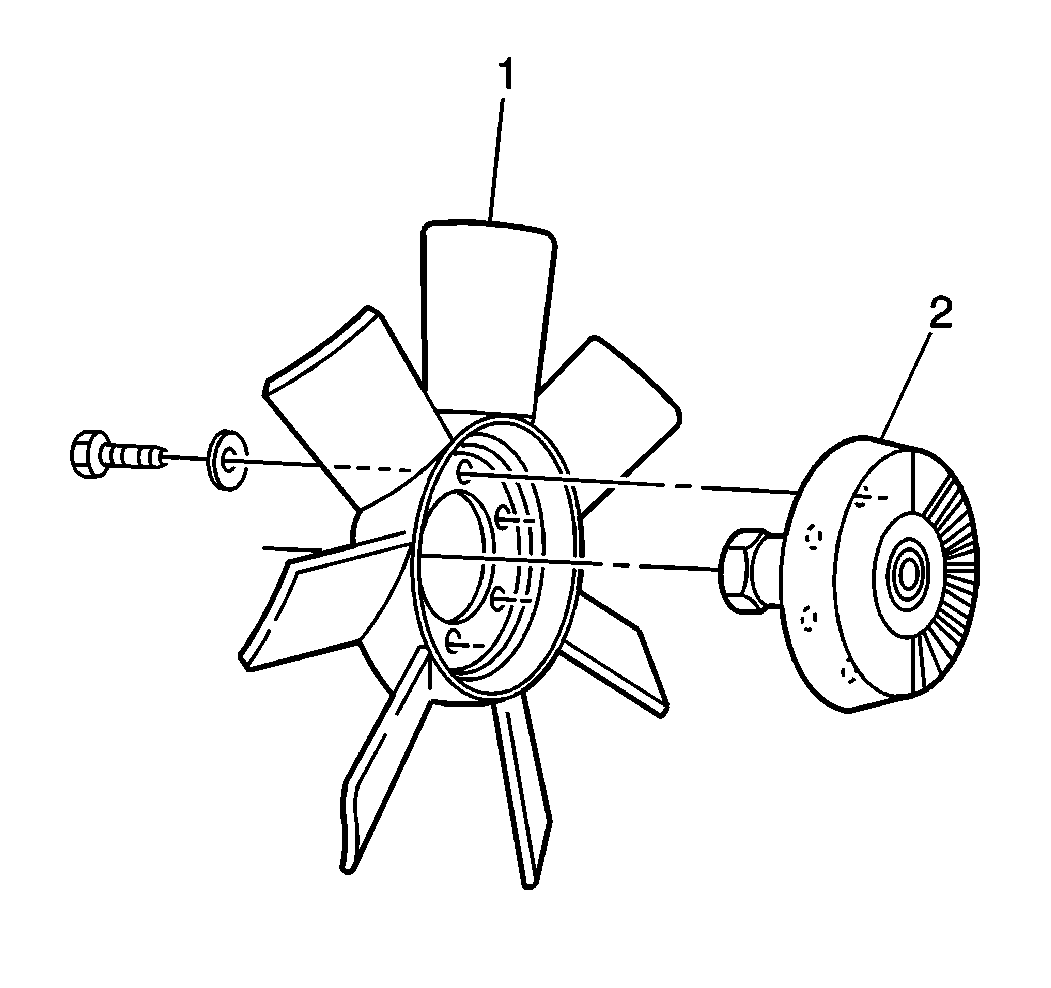Noise
Fan noise is sometimes evident when the following normal conditions exist:
| • | The clutch is engaged for maximum cooling. |
| • | The engine has been running for 15-60 seconds after start-up. |
| After this time, the clutch can redistribute the silicone fluid back to the normal disengaged operating conditions (after overnight settling). |

Fan noise or an excessive roar may occur when the following conditions exist:
| • | The engine speed is 2500 RPM or higher. |
| • | The clutch assembly is locked up due to an internal failure. |
Rotate the fan (1).
With the engine off, replace the clutch (2) if the following conditions exist:
- The fan cannot be rotated by hand.
- The fan produces a rough, grating feel as it turns.
Refer to Fan Replacement .
Looseness
If the fan assembly is loose, inspect the fan assembly for wear. Replace the fan assembly as necessary.
Observe the tip of the fan blade for lateral movement. Lateral movement occurs under various temperature conditions. A lateral movement measuring 6.5 mm (¼ in) is normal. This amount of movement is not cause for replacement of the assembly.
Silicone Fluid Leaks
Small fluid leaks that are present around the bearing assembly do not affect the fan clutch operation. If leakage appears extensive, replace the fan clutch. Refer to Fan Replacement .
Engine Overheating
Notice: Check for adequate clearance between the fan blades and the thermometer sensor before starting the engine, as damage could occur.
Use the following procedure in order to diagnose the causes of engine overheating:
- Ensure that the engine is cool. This will allow complete disengagement of the fan clutch.
- Spin the fan and clutch assembly by hand.
- If the fan clutch performs correctly but exhibits drag, position a thermometer between the fan blades and the radiator.
- Cover the radiator in order to induce a high engine temperature.
- Start the engine.
- Turn on the air conditioning.
- Operate the engine at 2000 RPM.
- Wait for 5 to 10 minutes while the temperature increases sufficiently to allow the fan clutch to engage. The following conditions indicate that the fan clutch has engaged:
- Observe the thermometer reading when the fan clutch engages.
- Perform the following steps as soon as the fan clutch engages:
- Observe the operation of the fan clutch.
Important: Testing the fan clutch by rotating the fan in a repeated clockwise/counterclockwise motion causes the clutch to free-wheel. Free-wheeling is a normal result of rotating the fan in this manner. Conduct further tests in order to determine if it is necessary to replace the fan clutch.
If the fan and clutch assembly revolves more than five times (free-wheels) with no drag, replace the fan clutch.
Notice: Check for adequate clearance between the fan blades and the thermometer sensor before starting the engine, as damage could occur.
Use any of the following methods in order to position the thermometer:
| • | Insert the thermometer sensor through one of the existing holes in the fan shroud. |
| • | Place the thermometer between the radiator and the shroud. |
| • | On models that do not have holes in the fan shroud, drill a 5 mm (3/16 in) hole in the fan shroud. Insert the thermometer in the hole. |
| • | A roaring noise or an increase in fan noise occurs. |
| • | The thermometer reading drops approximately 3-10°C (5-15°F). |
Important: Do not continue the test past a thermometer reading of 88°C (190°F). Continuing the test past a thermometer reading of 88°C (190°F) may cause engine overheating.
The following conditions are cause for replacement of the fan clutch:
| 9.1. | The fan clutch does not engage while the temperature measures 65-90°C (150-195°F). |
If the fan clutch does not engage while the temperature is within this range, verify that the fan clutch was disengaged at the beginning of the test.
| 9.2. | Both of the following conditions exist: |
| • | No temperature drop occurs |
| • | The fan noise level is constant from the beginning of the test until the time when the engine temperature reaches 88°C (190°F). |
| • | Do not continue the test past a thermometer reading of 88°C (190°F) in order to prevent overheating. |
| 10.1. | Remove the radiator cover. |
| 10.2. | Turn off the air conditioning. |
| 10.3. | Operate the engine at approximately 1500 RPM until the coolant returns to the normal operating temperature. |
The fan clutch should disengage after several minutes. Disengagement of the fan clutch is indicated by a decrease in fan noise or roar.
If the fan clutch does not disengage after several minutes, the fan clutch should be replaced.
